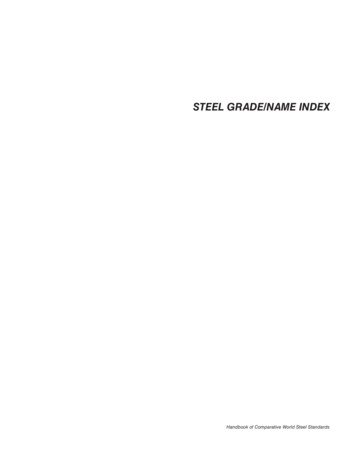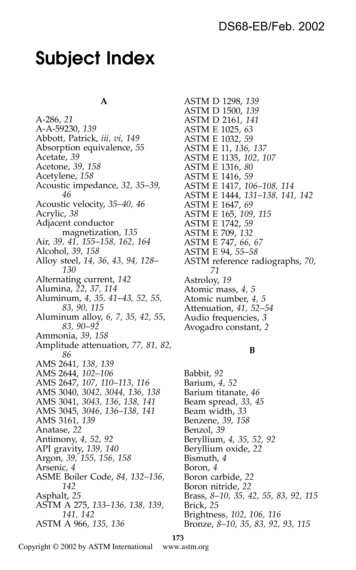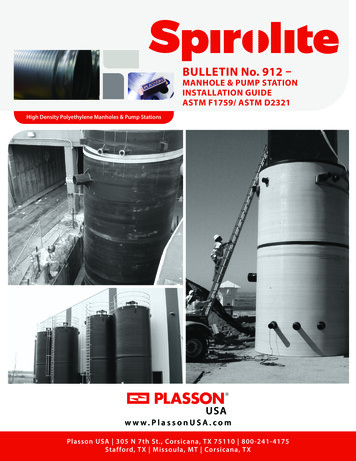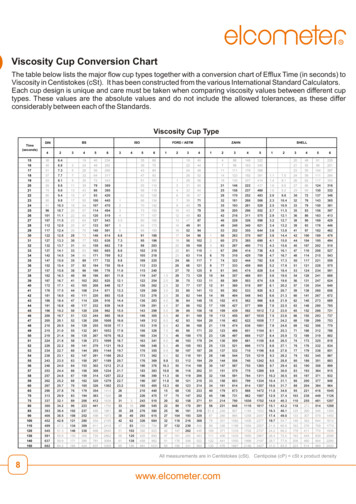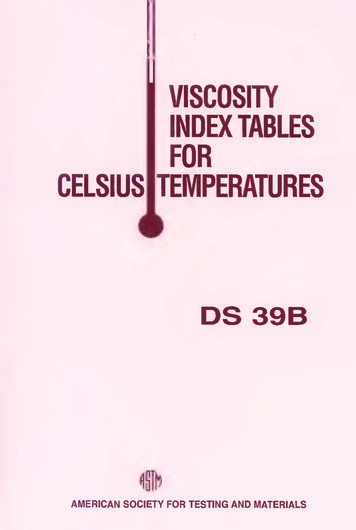
Transcription
VISCOSITY INDEX TABLESFOR CELSIUS TEMPERATURESASTM DATA SERIES PUBLICATION DS 39B05-039020-12AAMERICAN SOCIETY FOR TESTING AND MATERIALS1916 Race Street, Philadelphia, Pa. 19103
by AMERICAN SOCIETY FOR TESTING AND MATERIALS 1975Library of Congress Catalog Card Number: 75-10096ISBN 0-8031-0817-6NOTEThe Society is not responsible, as a body,for the statements and opinionsadvanced in this publication.Printed in Baltimore, Md.May 1975February 1986 Second PrintingJanuary 1990 Third PrintingNovember 1996 Fourth Printing
ForewordThese tables were prepared to provide a convenient means of obtainingthe viscosity index of petroleum products and lubricants without the necessity of calculation. They have been prepared under the sponsorship ofResearch and Development Division VII on Flow Properties of ASTMCommittee D-2.This publication is intended to replace the previous Viscosity IndexTables: DS 39a. Those were based on 100 and 210 F as referencetemperatures. These new tables are based on ASTM Method D 2270-74for Calculating Viscosity Index from Kinematic Viscosity at 40 and 100 C.Method D 2270-74 was prepared in compliance with worldwide agreementsreached within the International Standards Organization to adopt 40 and100 Celsius as the primary reference temperatures for the viscosity determinations of petroleum lubricants and related products. Research andDevelopment Division VII of ASTM Committee D-2 was requested byTechnical Committee 28 of the International Standards Organization toprepare a new standard for calculating viscosity index. This was to bebased on kinematic viscosities determined at 40 and 100 C, and to be inagreement with the prior Method D 2270-64 using 100 and 210 F. Itwas also requested that new Viscosity Index Tables be prepared whichwould obviate the necessity for detailed calculations. This publication fulfills that request.During the interim period in which the use of 100 and 210 F asreference temperatures is being phased out, either DS 39a or this newpublication can be used interchangeably.W. A. WrightPast ChairmanResearch and Development DivisionvnASTM Committee D-2
Acknowledgment of WorkPersonnel of Research and Development Division VII of ASTM Committee D-2 responsible for the development of ASTM Standard MethodD 2270-74, Calculating Viscosity Index From Kinematic Viscosity at 40and 100 C on which these viscosity index tables are based.W. A. Wright, Sun Oil CompanyA. F. Talbot, Sun Oil CompanyR. E. Manning, Cannon Instrument Company
IntroductionThe' tables in this publication permit direct reading of the viscosity indexof a petroleum product or lubricant if its kinematic viscosities at 40 and100 C are known. Use of these tables eliminates the calculations whichwould be required to determine the viscosity index.DefinitionThe viscosity index is an arbitrary number indicating the effect of changeof temperature on the kinematic viscosity of an oil. A high viscosity indexsignifies a relatively small change of kinematic viscosity with temperature.Calculation of Viscosity IndexThe viscosity index of an oil is calculated from its viscosities at 40 and100 C. The procedure for the calculation is given in ASTM MethodD 2270-74 for Calculating Viscosity Index from Kinematic Viscosity at40 and 100bC. Table 1 of the Method lists the basic viscosity values ofthe reference series used in the calculation. The accuracy of the calculatedviscosity index obtained by the use of Method D 2270 or the tables presented here is dependent on the accuracy of the viscosity determinations.It is recommended that the viscosity index be reported only to wholenumbers and that the use of decimal values be avoided.Structure and Use of the TablesThe tables are arranged according to the kinematic viscosity at 100 C.The viscosity at 100 C is given at the top of each column. The intervalsfor these viscosity values were selected on the basis of the importance ofthe size of the interval in a given viscosity range; ease of interpolation; andthe size of the resulting publication. The viscosity index values are givenin increments of one unit and are listed in the extreme left column. Theupper limit of viscosity index decreases with increasing viscosity on the
basis of practicality. The viscosities at 40 C are listed in the body of thetable. The use of the tables is illustrated by the following examples:Example 1What is the viscosity index of an oil for which the observed kinematicviscosities are 79.61 cSt at40 C and 9.12 cSt at 100 C?Enter the table in the column headed 9.12 under "Kinematic Viscosityat 100 C." Go down this column to the value 79.61.The left hand column on the same line gives the value 87. This is theviscosity index of the oil.Example 2What is the kinematic viscosity of an oil at 40 C which is required foran oil of 13.60 cSt at 100 C and 125 viscosity index?Enter the column headed 13.60 cSt at 100 C and proceed down thecolumn to the line at which 125 appears in the left hand column.The value found is 107.7 cSt, which is the required kinematic viscosityat 40 C.If the exact viscosities of an oil are not found in the table, the information desired can be obtained by linear interpolation between the propertabulated values. The viscosity index should be reported only to thenearest whole number.Method of Calculating Tabular Data and PublicationIt is considered desirable to record the procedures by which this editionof the ASTM Viscosity Index Tables were prepared. A computer wasprogrammed to perform the necessary calculations; type selection; andarrangement in the desired format. The mathematical equations given inASTM Method D 2270-74 were rearranged so that the required kinematicviscosities at 40 Cin the body of the table were determined for the specifiedvalues of the kinematic viscosity at 100 C and viscosity index. The equations used were as follows:For Oils of 0 to 100 VIU L -[(VI/100) (L-H)]For Oils of 100 VI and greaterU antilog [log H - N log Y]whereY kinematic viscosity of oil in centistokes at 100 C.L kinematic viscosity in centistokes at 40 C of an oil of 0 viscosityindex and having the same kinematic viscosity at 100 C as the oilwhose viscosity index is to be calculated.vi
H kinematic viscosity in centistokes at 40 C of an oil of 100 viscosityindex, and having the same kinematic viscosity at 100 C as the oilwhose viscosity index is to be calculated.U kinematic viscosity in centistokes at 40 C to be listed in the bodyof the table. When the tables are being used in the normal manner,this is also the kinematic viscosity at 40 C of the oil whose viscosityindex is being determined.N log [0.00715 (VI - 100) 1]The kinematic viscosities at 40 C in the table were tabulated to foursignificant figures. This represents an accuracy better than that normallyobtained in the laboratory and of the order of magnitude approached inprecise standardization studies. Independent recalculation of the tabulateddata given here might result in a possible deviation of one unit in thefourth digit. This deviation can arise from the rounding procedure usedby the computer when producing the tables. Normal laboratory practicesshould not be expected to provide significantly better viscosity or viscosityindex accuracy than provided for in the tables.ReferencesThe following references do not constitute a complete coverage of theliterature, but will be helpful in following the history and development ofthe viscosity index.Dean, E. W. and Davis, G. H. B., "Viscosity Variation of Oils and Temperature,"Chemical and Metallurgical Engineering, Vol. 36, 1929, pp. 618-619.Dean, E. W., Bauer, A. D., and Bergland, J. H., "Viscosity Index of LubricatingOils," Industrial and Engineering Chemistry, Vol. 32, 1940, pp. 102-107.Geniesse, I. C, "A Comparison of Viscosity Index Proposals," ASTM Bulletin,No. 215, 1956, pp. 81-84.Wright, W. A., "A Proposed Modification of the ASTM Viscosity Index," Proceedings, American Petroleum Institute, Vol. 44, Section 3, (Refining), 1964,pp. 535-541.Wright, W. A., Manning, R. E., and Talbot, A. F., "Metrication of the ViscosityIndex System—ASTM D 2270," ASTM Committee D-2 Research Report No. 1009;available from ASTM Headquarters, 1916 Race St., Philadelphia, Pa. 19103.VU
Research and Development Division VII on Flow Properties of ASTM Committee D-2. This publication is intended to replace the previous Viscosity Index Tables: DS 39a. Those were based on 100 and 210 F as reference temperatures. These new tables are based on ASTM Method D 2270-74 for Calculating Viscosity Index from Kinematic Viscosity at 40 and 100 C.File Size: 857KBPage Count: 9

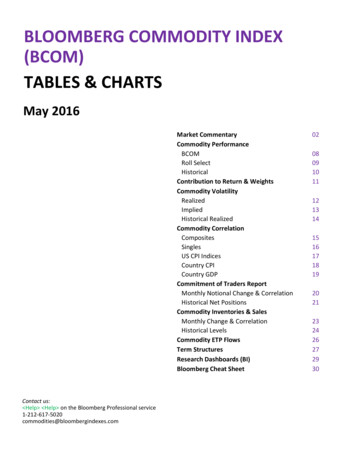
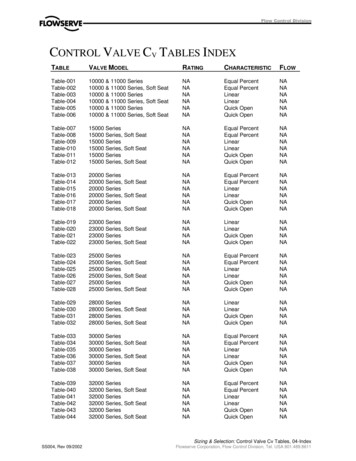
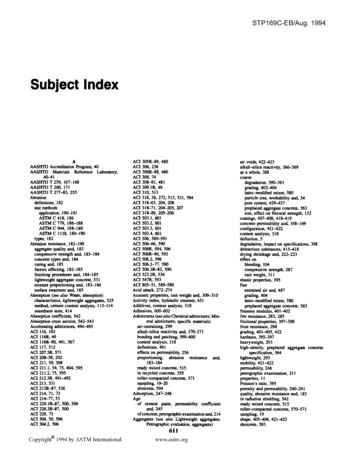
![Index [ astm ]](/img/5/stp37775s-index.jpg)
